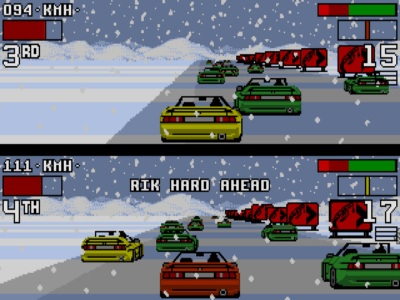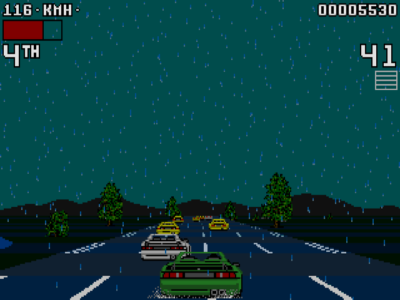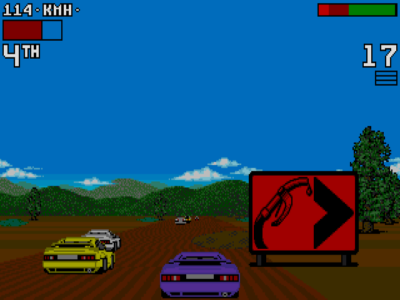
Lotus: The Ultimate Challenge
Written by: Rik
Date posted: April 28, 2010
- Genre: Racing
- Developed by: Magnetic Fields
- Published by: Gremlin
- Year released: 1993
- Our score: 4
Well, as my ol’ Dad would say, you live and learn. Despite being a massive nerd who has devoted a much-too-sizable portion of his life to playing old games, my reputation as a retro-gaming know-all (stop laughing at the back there) took a bit of a blow when I discovered that one of my older favourites, Lotus Esprit Turbo Challenge was never released on PC, and hence ineligible for coverage on FFG. Okay, so a DOS-based PC in 1991 wasn’t exactly the first place you’d go looking for an arcade racer, but I’d nevertheless assumed that if you were going to do an ST and an Amiga version, you may as well crank out one for the old beige box as well.
The first Lotus game doesn’t quite qualify as a 16-bit classic, but it’s nevertheless fairly fondly remembered by most of those who played it, myself included. It was a simpler game from a simpler time; a pseudo-3D racer in which you got to drive a Lotus Esprit in a series of races against other Lotus Esprits (is that the plural of Esprit? Write in – you could win a prize) driven by AI opponents with ‘comedy’ names from the world of motor racing (Nijel Mainsail, Ayrton Sendup – you get the idea).
Each race carried points towards an overall championship, and you had to at least finish in the top 10 to go on to the next race, otherwise it was ‘game over’. Despite employing a whole host of old-school ‘not fair’ irritations (starting at the back of the grid after winning a race, collisions only ever affecting your car, obstacles in the middle of the road) it was – is – oddly compulsive stuff that could certainly keep you entertained throughout a rainy Saturday afternoon. But only if you owned an Amiga or ST [Or one of the many 8-bit systems on which the game was also released – FFG pedant].
What we’re dealing with here, though, is the second sequel, the third game in the series, and the first to be released on PC. Given the marked similarities in visual style between this and the original (which is a polite way of saying they look exactly the bloody same) it’s clear that nothing wildly revolutionary has been attempted here, and instead new features and innovations have been added to the same basic game engine in order to try and create the ‘ultimate’ Lotus game (hence the title, I suppose).
The game’s makers say as much in the opening pages of the manual, in which they explain their original intention to move on to different projects before being talked into another Lotus game by devoted fans – although work only commenced after giving ‘serious consideration’ to whether they could deliver a game with enough new content and features to make it a worthy addition to the series (insert your own sarcasm here). They also, helpfully, provide a breakdown of what’s new, and why those things are so great, so, seeing as I’m incredibly lazy, we may as well go through them one by one, and I’ll tell you what I think as we go along. Yay!
“As well as all the features brought over from the first two games, crammed in there are five new themed levels, each with it’s [sic] own unique graphic style, and new features that affect the handling of your car.”
Granted, Lotus: TUC does have quite a lot of different environments to choose from. The first game was largely restricted to tarmac, but here you can drive in mud, and snow, and rain, and wind, on a motorway, erh, and loads of others. It’s not that you can’t tell them apart, more that none of them are desperately interesting. The only one that really stands out most for me is the ‘wacky’ futuristic setting, where the road is a headache-inducing chequered pattern and you’re occasionally stopped by some kind of laser barrier in the middle of the road. It’s toss. Elsewhere, the weather does seem to have an effect on your car, especially the wind, which sends your Lotus veering across the track at inopportune moments, but your Lotus won’t ever crash or spin, not even in the iciest of conditions.
“There is the stunning new Lotus concept car, the M200. This car will never go into production, so this will be the only opportunity you will ever get to ‘drive’ one.”
So you have a total of three Lotus cars to choose from – the Esprit, the Elan and, of course, the ‘stunning’ M200 (Google it and see if you agree). They all look pretty similar from behind, though, and as for differences in handling, acceleration etc – you’d be hard pressed to tell from the gameplay. There are some helpful graphs that tell you about this kind of thing when choosing your car, and they seem to confirm that the Esprit is the fastest and the M200 is the slowest. I suppose if you were the kind of person who watched Top Gear in 1993 being able to drive it could potentially be exciting, but from a personal point of view they may as well have included a car that the developers had just made up on the spot, referred to it as a ‘stunning Lotus concept car’ and it would have made no difference to me.

Actually, I’m controlling both cars. If I had any friends, I wouldn’t invite them to play this with me.
“The most startling addition, however, is the stunning RECS system, which will give you access to a practically infinite number of different tracks.”
Right, well, so this thing called RECS can apparently produce somewhere in the region of three trillion tracks, which sounds jolly exciting until you realise that a) you actually have very little control over the design of each track, and b) you’d have to have a PhD in being particularly observant to tell the difference between the vast majority of them:
“Just about every other game to feature a track creation system has followed the standard system of including a track editor, which means having to spend maybe an hour or more designing a single track.”
Yeah, what a drag it is in a game such as Stunts to have so much control over the design of your tracks that you actually want to spend valuable time creating and tweaking one that you might actually race on more than once. RECS is miles better – you just select the scenery, choose what percentage hilliness and, er, corneriness (among other similarly mundane variables) you want, and away you go!
And, well, that’s it. So, the new stuff essentially amounts to some additional scenery, the pointless extra car and the rubbish track generator. Still, putting an unnecessarily mean-spirited dissection of the game manual aside [it took you long enough – FFG reader] – none of this should really matter as long as the core game is good, especially given that the first two games weren’t released on PC.
Unfortunately, though, Lotus: TUC falls short on this front. The first game may have been a relatively unambitious arcade racer, but it did what it did well. There may not have been three trillion tracks to choose from, but the ones that were there were well designed, with each race a tightly-balanced battle to get to the front of the grid before the number of laps remaining ran out. That sense of involvement is sadly lacking here: each course has a very generic feel, despite the additional scenery on offer, and the races seem to go on forever. For want of a better word, it’s boring, and it’d take a very committed soul indeed to persist with the lengthier championship options.
Sequels such as this should, by all rights, be at least as good as the original, offer marginal or superficial improvements, or better still represent a significant leap forward for the series (or even the genre). Unfortunately, in attempting to create the ‘ultimate challenge’ for followers of the previous Lotus titles, the game underneath has been exposed as a fairly basic and unengaging racer. I’m not normally one to harp on about the original being better, but in this case, it is – so dig out your emulator (see Evidence-based nostalgic ramblings for more).





 Posts
Posts